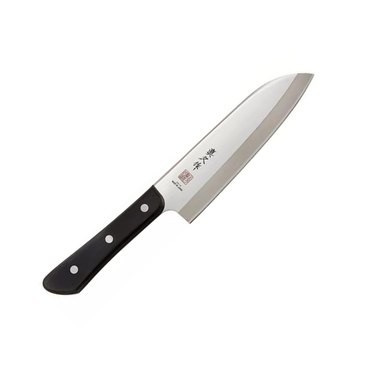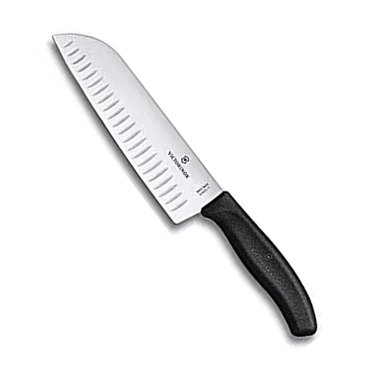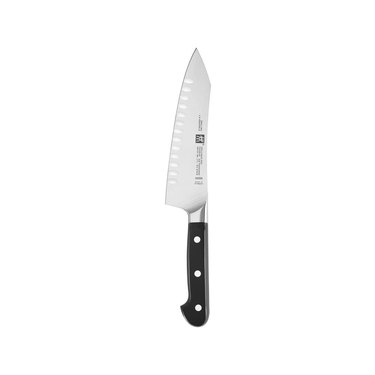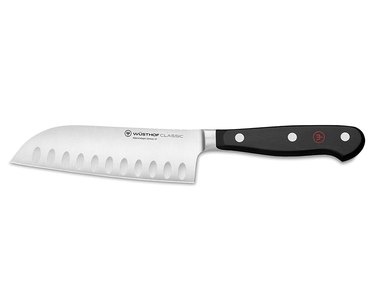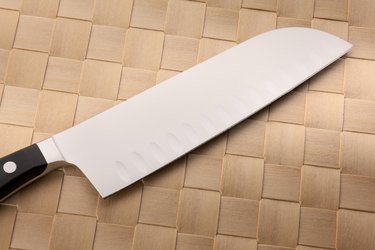
Historically, the Japanese have been great believers in having specialized knives for distinct kitchen tasks. In the postwar years as they evaluated Western ways with a keenly interested eye, they came to appreciate the value of knives which—like the best chef's knives—would be versatile, all-around general-purpose kitchen tools.
Ultimately, they would come up with two options. One, the gyutou, is the Japanese version of a full-sized chef's knife. The other, the santoku, is a smaller but nimbler knife designed to retain many of the virtues of a nakiri (vegetable knife) while also being able to tackle meat, fish and poultry with equal ease. The best santoku knives still do all of those things, but some do it better than others. Here are a handful of the top models.
Video of the Day
Video of the Day
What to Consider When Purchasing a Santoku
So what are santoku knives used for? Just about everything, which is precisely why they're such a mainstay in the kitchen. They're too small to excel as slicing knives and too large to be useful in lieu of a paring knife, but they're good for just about everything in between.
That versatility means you'll use a santoku knife a lot, which in turn means you'll want to put some serious effort into choosing the right one. A few points to consider include:
Handle Style: Japanese knives traditionally feature a D-shaped or octagonal handle, which is smaller and lighter in weight than a Western-style handle. Santokus, of course, are not traditional knives, so you'll also see them with Western-style handles or hybrids that incorporate features from both traditions. Choose one that's comfortable in your hand, and provides a good grip even when wet.
Size: You'll find santoku-style knives that are barely larger than a paring knife, but 5 to 8 inches is the typical range, and most fall between 6 and 7.5 inches in blade length. Generally, a santoku should be lighter than a Western knife of similar size and with a thinner but harder blade.
The Shape of the Cutting Edge: Most santokus have a relatively flat cutting edge compared to European chef knives. Western cookery calls for food to be cut with a rocking motion, and a rounded blade makes that easier. The flat blade of a santoku is better for a straight up-and-down chopping motion, or for sliding the blade front-to-back through your ingredients as you cut. That being said, many companies make a santoku-style knife with a curved cutting edge, which can be used for Western-style chopping.
The Thickness and Style of the Blade: Japanese knives are typically made from thin, hard steel and sharpened at a very fine angle. Western knives tend to be thicker and sharpened to a less acute angle. Santoku blades are usually thin, but you'll see some models with a thicker European-style blade. Many santokus are also hollow-ground, which gives a thinner (and therefore sharper) cutting edge. The downside is that they're harder for home cooks to sharpen, even with a very good sharpener.
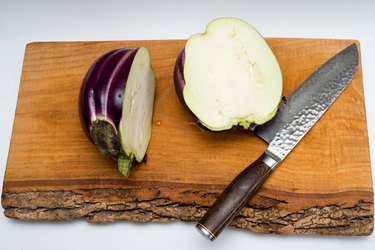
The Best Overall Santoku Knife
Shun Classic 7-inch Santoku Knife
If you were to make a mental picture of an idealized, perfect santoku knife, a Shun resembles it pretty closely. The lightweight handle is made of ebony pakka wood and the 7-inch blade is made of Shun's proprietary VG-MAX steel alloy clad in layered hand-forged Damascene steel for added durability (and beauty, too). The knife is very lightweight for its size at just over 7 ounces, so it's easy to use for extended periods, and the slender, hollow-ground Granton edge (that means it has dimples, to keep food from sticking) will glide with incredible ease through produce, fish and meats alike. Just don't use it for cutting through bones (bring out a cleaver or European-style chef's knife for that). The super-sharp blade holds an edge exceptionally well, but it will need occasional touch-ups on a steel and periodic sharpening in order to give the best performance.
The Best Value Santoku Knife
MAC Superior Santoku
This santoku from MAC Knives lacks the elegance and traditional Japanese styling of the Shun, but you could make a case for it providing even better bang for the buck. It's just slightly heavier at 8.4 ounces and has a more utilitarian appearance, but the hollow-ground blade is made of high-carbon steel that takes—and holds—a genuinely wicked edge. The handle of this knife is compact and generally Western in design, and overall the knife is nimble and a pleasure to use. Like the Shun, it should be hand-washed, and because the high-carbon steel is not clad in a rust-resistant alloy, it should also be dried immediately to minimize the risk of corrosion. If you want a high-quality cutting tool at a price that won't leave your wallet whimpering, the MAC is an outstanding value at the price point.
The Best Budget Santoku Knife
Victorinox 7-inch Fibrox Pro Santoku Knife
Victorinox—the Swiss Army Knife company—isn't exactly a prestige brand in the knife world. The brand is well-respected for manufacturing solid workmanlike blades that can stand up to heavy use. As a European maker, their blades are thicker and their steel is not as hard as the alloys used in Japanese knives, but that's not all bad. Japanese knives tend to be brittle and can chip if misused, but the Victorinox (and similar knives from other manufacturers) can stand up to some abuse. In fact, they're a good knife to keep around for others to use while you baby your more cherished blades. Another virtue of their softer steel is that it's easier for inexperienced users to sharpen, which means you can do it yourself with a good sharpener instead of sending them to a professional. One other good feature is the "Fibrox" handles that give Victorinox kitchen knives their name. The textured grip fits most hands comfortably, and won't easily slip even if your hands are wet or greasy.
The Best Rocking-Blade Santoku Knife
Zwilling Pro 7 Hollow Edge Rocking Santoku Knife
While most santokus are meant to be used in a Japanese-style cutting motion—a front-to-back stroke with an angled blade or straight up-and-down chopping—some are designed instead with a curving European-style blade. These hybrid knives give you the relatively compact size and styling of a conventional santoku, but without forcing you to unlearn your Western-style cutting skills. If you're interested in going that route, this santoku from Henckels is a fine example of the style. The back half of the blade is flat enough to be used Japanese-style, but the front half has enough of a curve to work well with a Western-style rocking motion. The blade also has a bit more of a point than most santokus, another nod to Western knife styles. Overall, it's an excellent blend of Western and Japanese traditions.
The Best 5-inch Santoku Knife
Wusthof Classic 5-inch Santoku Knife
If you have smaller hands or just want a compact, nimbler santoku knife, Wüsthof has you covered. The blade is forged from a single piece of the company's signature high-carbon alloy, giving it excellent balance, and the handle is a composite synthetic material that's both durable and maintenance-free. Among Western manufacturers, Wüsthof has learned the most from its Japanese peers and this little hollow-ground santoku is as slender, sharp and light (at just over 5 ounces), as anything hailing from Asia. This is an excellent option whether it's your main knife or the backup to a larger santoku or chef's knife.
The Best Santoku Knife for Lefthanders
Tojiro DP Santoku
One minor quirk of Japanese-made knives is that the blades are usually sharpened asymmetrically, with one side at a sharper angle than the other. That makes for exceptionally clean and easy cutting, as long as you're using the knife right-handed, but it means southpaws are out of luck. Similarly, the classic Japanese D-shaped handle has a small ridge at one side to make it more comfortable in a right-handed grip. This beautifully-crafted santoku from Tojiro—a solid contender in the "value" category—addresses both issues with a blade that's sharpened to the same angle on both sides and has a Western-inspired handle that's also suitable for ambidextrous use. Aside from that, like other knives from Tojiro, it offers surprisingly high-quality workmanship and cutting ability at a moderate price point. It's hard to argue against this much bang for the buck, especially if you're left-handed.

